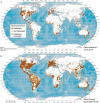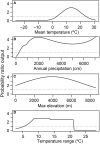Global Patterns of the Fungal Pathogen Batrachochytrium dendrobatidis Support Conservation Urgency
- PMID: 34336978
- PMCID: PMC8322974
- DOI: 10.3389/fvets.2021.685877
Global Patterns of the Fungal Pathogen Batrachochytrium dendrobatidis Support Conservation Urgency
Erratum in
-
Corrigendum: Global Patterns of the Fungal Pathogen Batrachochytrium dendrobatidis Support Conservation Urgency.Front Vet Sci. 2022 Feb 8;9:825058. doi: 10.3389/fvets.2022.825058. eCollection 2022. Front Vet Sci. 2022. PMID: 35211542 Free PMC article.
Abstract
The amphibian chytrid fungus Batrachochytrium dendrobatidis (Bd) is a skin pathogen that can cause the emerging infectious disease chytridiomycosis in susceptible species. It has been considered one of the most severe threats to amphibian biodiversity. We aimed to provide an updated compilation of global Bd occurrences by host taxon and geography, and with the larger global Bd dataset we reanalyzed Bd associations with environmental metrics at the world and regional scales. We also compared our Bd data compilation with a recent independent assessment to provide a more comprehensive count of species and countries with Bd occurrences. Bd has been detected in 1,375 of 2,525 (55%) species sampled, more than doubling known species infections since 2013. Bd occurrence is known from 93 of 134 (69%) countries at this writing; this compares to known occurrences in 56 of 82 (68%) countries in 2013. Climate-niche space is highly associated with Bd detection, with different climate metrics emerging as key predictors of Bd occurrence at regional scales; this warrants further assessment relative to climate-change projections. The accretion of Bd occurrence reports points to the common aims of worldwide investigators to understand the conservation concerns for amphibian biodiversity in the face of potential disease threat. Renewed calls for better mitigation of amphibian disease threats resonate across continents with amphibians, especially outside Asia. As Bd appears to be able to infect about half of amphibian taxa and sites, there is considerable room for biosecurity actions to forestall its spread using both bottom-up community-run efforts and top-down national-to-international policies. Conservation safeguards for sensitive species and biodiversity refugia are continuing priorities.
Keywords: Bd; amphibian chytrid; climate associations; emerging infectious disease; fungal pathogen.
Copyright © 2021 Olson, Ronnenberg, Glidden, Christiansen and Blaustein.
Conflict of interest statement
The authors declare that the research was conducted in the absence of any commercial or financial relationships that could be construed as a potential conflict of interest.
Figures








References
-
- Dirzo R, Raven PH. Global state of biodiversity and loss. Annu Rev Env Resour. (2003) 28:137–67. 10.1146/annurev.energy.28.050302.105532 - DOI
-
- International Union for the Conservation of Nature . IUCN Red List of Threatened Species. Version 2020-3 (2021). Available online at: https://www.iucnredlist.org (accessed February 1, 2021).
LinkOut - more resources
Full Text Sources
Research Materials

